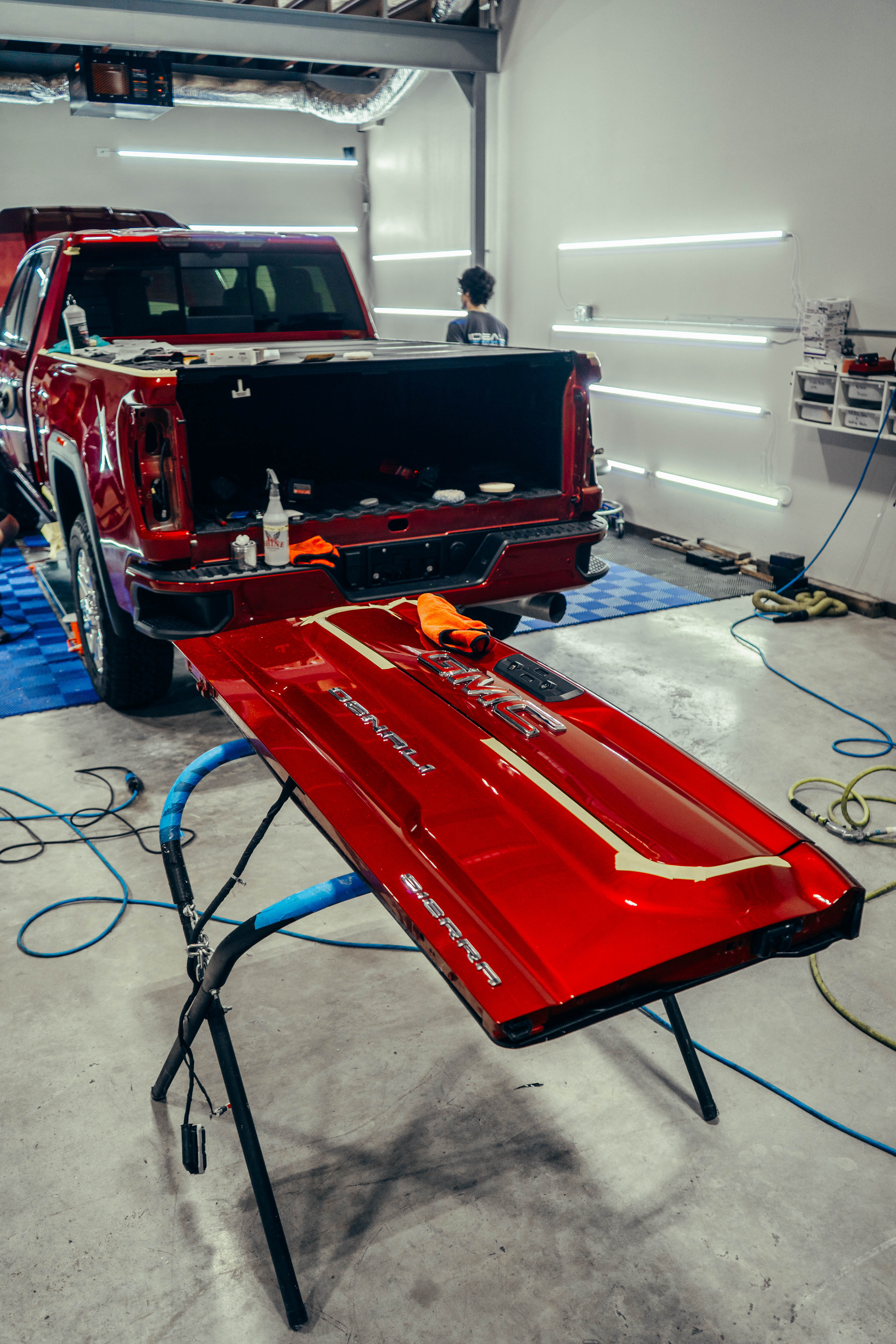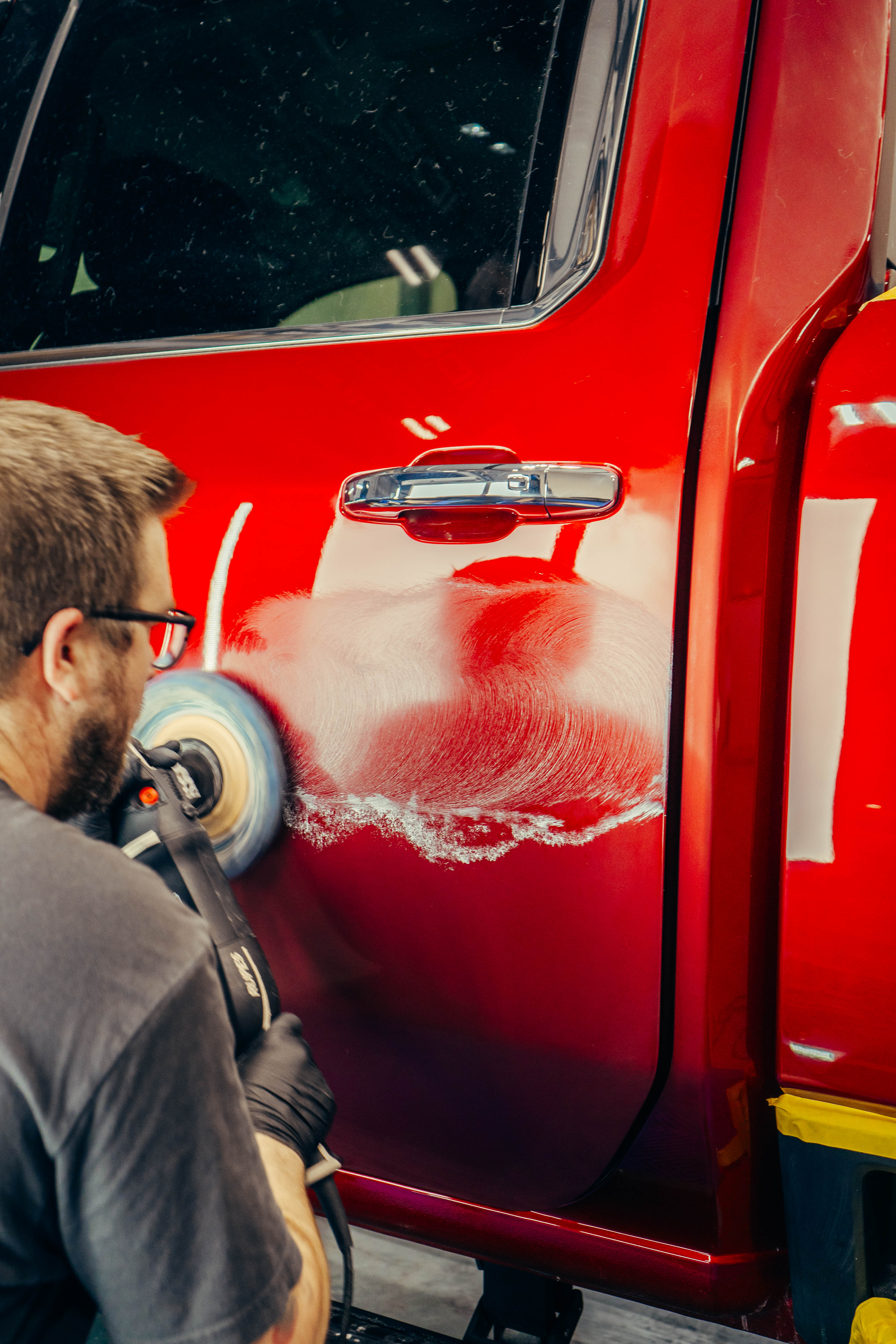Back
October 3rd, 2024 — 8 min read
What is Paint Enhancement and How Does It Work?
What is Paint Enhancement and How Does It Work?
What is Paint Enhancement
and How Does It Work?




What is a Paint Enhancement?
What is a Paint Enhancement?
Paint enhancement is often confused with paint correction. And while they are similar, there is a key difference. Paint enhancement is the process of improving the appearance of your paint by removing light surface scratches, swirl marks, and other defects, while also adding gloss and protection.
The appearance of vehicle paint can be improved with the application of a specialist service known as “car paint enhancement.” It is able to erase light scratches and remove swirl marks, bring fading paint work back to its original color, as well as add depth and gloss to the finish. The level of enhancement is often determined by the condition of the paint as well as the outcomes that are wanted, and professional detailers make use of a wide number of techniques and products in order to achieve these results.
Paint enhancement is often confused with paint correction. And while they are similar, there is a key difference. Paint enhancement is the process of improving the appearance of your paint by removing light surface scratches, swirl marks, and other defects, while also adding gloss and protection.
The appearance of vehicle paint can be improved with the application of a specialist service known as “car paint enhancement.” It is able to erase light scratches and remove swirl marks, bring fading paint work back to its original color, as well as add depth and gloss to the finish. The level of enhancement is often determined by the condition of the paint as well as the outcomes that are wanted, and professional detailers make use of a wide number of techniques and products in order to achieve these results.
Paint enhancement is often confused with paint correction. And while they are similar, there is a key difference. Paint enhancement is the process of improving the appearance of your paint by removing light surface scratches, swirl marks, and other defects, while also adding gloss and protection.
The appearance of vehicle paint can be improved with the application of a specialist service known as “car paint enhancement.” It is able to erase light scratches and remove swirl marks, bring fading paint work back to its original color, as well as add depth and gloss to the finish. The level of enhancement is often determined by the condition of the paint as well as the outcomes that are wanted, and professional detailers make use of a wide number of techniques and products in order to achieve these results.
What Paint Enhancement Isn’t
What Paint Enhancement Isn’t
Paint enhancement is not the same thing as paint correction. Minor paint correction is a deeper level of polishing that is required when the paint has been severely damaged or has gone through years of neglect. It usually involves more aggressive polishing and may sometimes require wet sanding in order to level out the surface before any further work can be done. Paint enhancement is also not a service that you can do at home. It requires the use of specialized equipment and products that are not available to the general public.
Paint enhancement is not the same thing as paint correction. Minor paint correction is a deeper level of polishing that is required when the paint has been severely damaged or has gone through years of neglect. It usually involves more aggressive polishing and may sometimes require wet sanding in order to level out the surface before any further work can be done. Paint enhancement is also not a service that you can do at home. It requires the use of specialized equipment and products that are not available to the general public.
Paint enhancement is not the same thing as paint correction. Minor paint correction is a deeper level of polishing that is required when the paint has been severely damaged or has gone through years of neglect. It usually involves more aggressive polishing and may sometimes require wet sanding in order to level out the surface before any further work can be done. Paint enhancement is also not a service that you can do at home. It requires the use of specialized equipment and products that are not available to the general public.
Paint Enhancement vs Paint Correction
Paint Enhancement vs Paint Correction
Paint correction is the process of removing defects from the paint surface, such as swirl marks, scratches, etching, and holograms. The goal is to return the paint to its original condition when it left the factory. This is a multi-step process that may require compounding, polishing, and protection.
Paint enhancement is a process that improves the paint’s condition beyond its original state. The goal is to create a deep, glossy, and wet-looking finish. This can be achieved with a single-stage machine polish or a two-stage process that includes compounding and polishing.
Their difference? Paint correction is a restorative process, while paint enhancement is a preventive one.
Paint correction is the process of removing defects from the paint surface, such as swirl marks, scratches, etching, and holograms. The goal is to return the paint to its original condition when it left the factory. This is a multi-step process that may require compounding, polishing, and protection.
Paint enhancement is a process that improves the paint’s condition beyond its original state. The goal is to create a deep, glossy, and wet-looking finish. This can be achieved with a single-stage machine polish or a two-stage process that includes compounding and polishing.
Their difference? Paint correction is a restorative process, while paint enhancement is a preventive one.
Paint correction is the process of removing defects from the paint surface, such as swirl marks, scratches, etching, and holograms. The goal is to return the paint to its original condition when it left the factory. This is a multi-step process that may require compounding, polishing, and protection.
Paint enhancement is a process that improves the paint’s condition beyond its original state. The goal is to create a deep, glossy, and wet-looking finish. This can be achieved with a single-stage machine polish or a two-stage process that includes compounding and polishing.
Their difference? Paint correction is a restorative process, while paint enhancement is a preventive one.
What Does Paint Enhancement Include?
What Does Paint Enhancement Include?
Paint enhancement services usually include:
Full decontamination of the vehicle will remove all bonded contaminants from the surface of the paintwork. This is an important first step as it allows for the maximum level of correction to be achieved.
A single-stage machine polish that safely removes surface scratches and defects, while also adding gloss and depth to the paint.
The application of a quality carnauba wax or sealant will protect the enhanced paintwork and maintain that just-polished look for longer.
Why You Might Need Paint Enhancement Services
Why You Might Need Paint Enhancement Services
Your car’s paint is starting to look dull and faded.
Your car’s paint is starting to look dull and faded.
Your car’s paint is starting to look dull and faded.
You have some light surface scratches or swirl marks that you want to remove.
You have some light surface scratches or swirl marks that you want to remove.
You have some light surface scratches or swirl marks that you want to remove.
You want to add depth, gloss, and protection to your paint.
You want to add depth, gloss, and protection to your paint.
You want to add depth, gloss, and protection to your paint.
You are selling your car and want to make it look its best.
You have just bought a new car and want to protect the paintwork.
How The Paint Enhancement Process Works
How The Paint Enhancement Process Works
Step 1: Decontamination
The first step is to decontaminate the surface of the paint. This is done in order to remove all bonded contaminants from the paintwork. These contaminants can include things like tar, tree sap, and brake dust. Most detailers will use a clay bar to do this. Note that this step is important because it allows for the maximum level of correction to be achieved. If the surface of the paint is not properly decontaminated, then it will be difficult to achieve a high level of gloss and depth.
The first step is to decontaminate the surface of the paint. This is done in order to remove all bonded contaminants from the paintwork. These contaminants can include things like tar, tree sap, and brake dust. Most detailers will use a clay bar to do this. Note that this step is important because it allows for the maximum level of correction to be achieved. If the surface of the paint is not properly decontaminated, then it will be difficult to achieve a high level of gloss and depth.
Step 2 - Compounding (if necessary)
The second step is to compound the paint if necessary. This step is usually only necessary if the paint is in bad condition. Compounding helps to remove heavy scratches, etchings, and holograms. Once you’ve compounded the paint, you’ll need to polish it in order to achieve the desired result.
The second step is to compound the paint if necessary. This step is usually only necessary if the paint is in bad condition. Compounding helps to remove heavy scratches, etchings, and holograms. Once you’ve compounded the paint, you’ll need to polish it in order to achieve the desired result.
Step 3 - Polishing
The third step is to polish the paint. This step is necessary in order to remove light scratches and defects, while also adding gloss and depth to the paint. Polishing is usually done with a machine polisher and a variety of different polishing pads. Most detailers will use a two-stage process that includes both compounding and polishing. However, it is possible to achieve good results with a single-stage machine polish.
The third step is to polish the paint. This step is necessary in order to remove light scratches and defects, while also adding gloss and depth to the paint. Polishing is usually done with a machine polisher and a variety of different polishing pads. Most detailers will use a two-stage process that includes both compounding and polishing. However, it is possible to achieve good results with a single-stage machine polish.
Step 4 - Waxing or Sealing
The fourth step is to wax or seal the paint. This step is necessary in order to protect the enhanced paintwork and maintain that just-polished look for longer. Waxing or sealing also makes it easier to wash and maintain the paintwork in the future. Most detailers will use a carnauba wax because it provides good protection and durability. However, some detailers prefer to use a sealant because it is easier to apply and can last longer.
The fourth step is to wax or seal the paint. This step is necessary in order to protect the enhanced paintwork and maintain that just-polished look for longer. Waxing or sealing also makes it easier to wash and maintain the paintwork in the future. Most detailers will use a carnauba wax because it provides good protection and durability. However, some detailers prefer to use a sealant because it is easier to apply and can last longer.
Step 5 - Final Inspection
The final step is to inspect the paintwork and make sure that you are happy with the results. This step is important because it allows you to see the finished product and make sure that everything has been done to your satisfaction. If you are not happy with the results, then you can always speak to the detailer and see if they can make any adjustments. Paint enhancement is a great way to protect your paintwork and maintain that just-polished look for longer. If you’re thinking about getting paint enhancement services, then be sure to follow the steps outlined above. Doing so will ensure that you get the best possible results.
The final step is to inspect the paintwork and make sure that you are happy with the results. This step is important because it allows you to see the finished product and make sure that everything has been done to your satisfaction. If you are not happy with the results, then you can always speak to the detailer and see if they can make any adjustments. Paint enhancement is a great way to protect your paintwork and maintain that just-polished look for longer. If you’re thinking about getting paint enhancement services, then be sure to follow the steps outlined above. Doing so will ensure that you get the best possible results.
What to Expect After Paint Enhancementm line: should you use paint protection film on your vehicle?
What to Expect After Paint Enhancementm line: should you use paint protection film on your vehicle?
After the paint enhancement process is completed, you can expect to see a significant difference in the way your paint looks. The level of improvement will vary depending on the condition of your paint and the amount of work that was done. In most cases, you can expect to see an increase in gloss, depth, and clarity. You may also see an improvement in the overall condition of your paint. So, if I were you, I’d highly recommend getting Fort Worth paint enhancement services done on your car. It’s a great way to protect your investment and keep your car looking its best.

PARALLAX

Resources
PARALLAX
